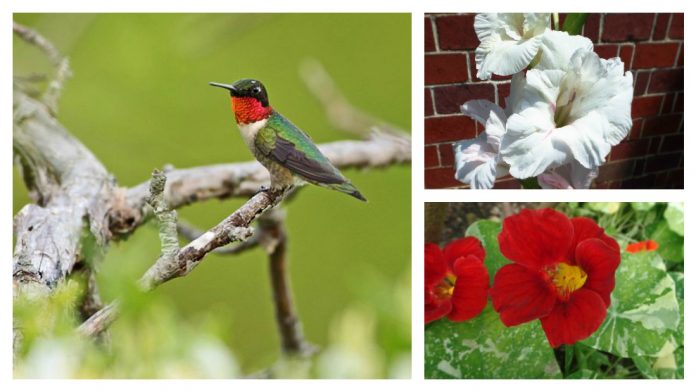Every spring I look forward to the return of the hummingbirds. In April, I fill feeders with sweet sugar-water. I plant pollinator-friendly bulbs and seeds in May. By June my pollinator garden is crowded with colorful nasturtium, bee balm and bluebells. I sit back and wait impatiently for the ruby-throats to arrive. Imagine my dismay as July came to close and I had yet to see a single bird.
Ruby-throated hummingbirds are one of sixteen species commonly found in the United States. Each year they migrate to the eastern U.S. from Mexico and South America. They typically arrive in Ohio mid-April and depart when the weather cools in fall.
Food, flowers and cover
Food, flowers and cover are the key to attract hummingbirds to your yard.
Food
Hummingbird feeders are a critical source of food when birds arrive tired and thirsty in early spring, before nectar-bearing flowers are in bloom. I fill red-tinted feeders with a simple, homemade sugar-water solution instead of purchasing premade mixes containing red dye. I refill my feeders regularly to provide birds with a consistent source of food. Doing so encourages them to build nests nearby and return year after year.
DIY homemade sugar-water solution for hummingbird feeders:
In a large stockpot, mix together 1 part sugar to 4 parts water. Bring to a boil, stirring constantly until sugar dissolves completely. Remove from heat. Cool solution completely.
Flowers
Hummingbirds have a poor sense of smell, but a good sense of sight. They seek out colorful, tube-shaped flowers that facilitate their long beaks and tongues. Plant strategically to provide continuous sources of food from early spring to mid-fall. My garden’s biggest hummingbird hits:
| Plant Name | Bloom Season |
| Bee balm | Early- Mid |
| Columbine | Early-Mid |
| Virginia bluebell | Early-Mid |
| Butterfly weed | Mid- Late |
| Foxglove | Mid-Late |
| Hosta | Mid-Late |
| Lily | Mid-Late |
| Nasturium | Mid-Late |
| Gladiolus | Mid-Late |
Cover
Hummingbirds seek out safe, sheltered areas to build their nests. They favor shrubs, bushes and small trees. Females return to the same area each year, sometimes reusing nests. Hummingbirds use leaves, twigs, grass, lichen, and moss to build the exterior of their nests. They line the interior with thistle and dandelion fluff to create a soft cushion for their tiny, fragile eggs.
This week I was bent over weeding when a buzz brazed by my head, then another, and another! I looked up to witness seven ruby-throated hummingbirds dancing through my pollinator garden. They hovered in mid-air, drinking heartily from the feeders. “Better late than never!” I cheered.












